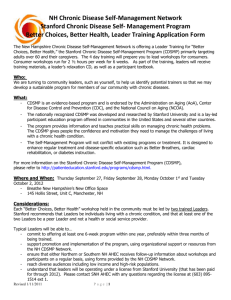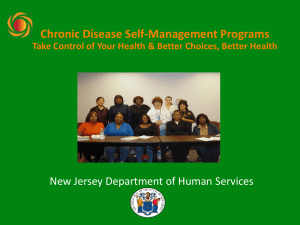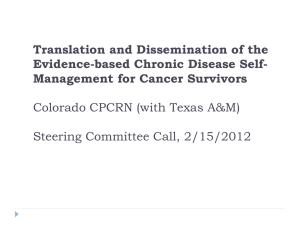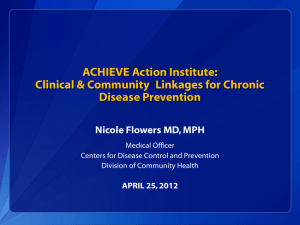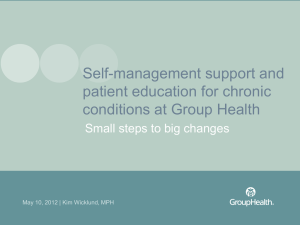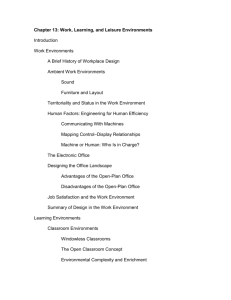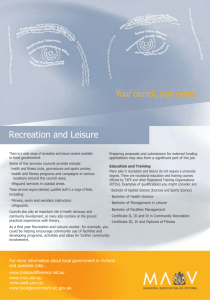Flagship Proposal Outline
advertisement
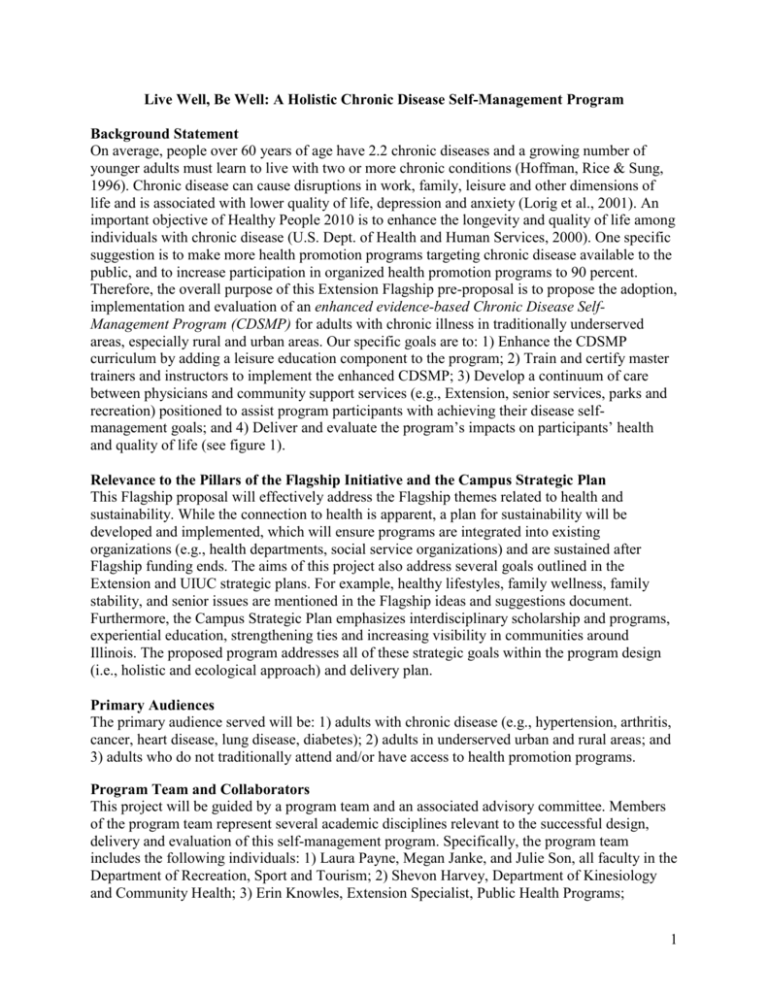
Live Well, Be Well: A Holistic Chronic Disease Self-Management Program Background Statement On average, people over 60 years of age have 2.2 chronic diseases and a growing number of younger adults must learn to live with two or more chronic conditions (Hoffman, Rice & Sung, 1996). Chronic disease can cause disruptions in work, family, leisure and other dimensions of life and is associated with lower quality of life, depression and anxiety (Lorig et al., 2001). An important objective of Healthy People 2010 is to enhance the longevity and quality of life among individuals with chronic disease (U.S. Dept. of Health and Human Services, 2000). One specific suggestion is to make more health promotion programs targeting chronic disease available to the public, and to increase participation in organized health promotion programs to 90 percent. Therefore, the overall purpose of this Extension Flagship pre-proposal is to propose the adoption, implementation and evaluation of an enhanced evidence-based Chronic Disease SelfManagement Program (CDSMP) for adults with chronic illness in traditionally underserved areas, especially rural and urban areas. Our specific goals are to: 1) Enhance the CDSMP curriculum by adding a leisure education component to the program; 2) Train and certify master trainers and instructors to implement the enhanced CDSMP; 3) Develop a continuum of care between physicians and community support services (e.g., Extension, senior services, parks and recreation) positioned to assist program participants with achieving their disease selfmanagement goals; and 4) Deliver and evaluate the program’s impacts on participants’ health and quality of life (see figure 1). Relevance to the Pillars of the Flagship Initiative and the Campus Strategic Plan This Flagship proposal will effectively address the Flagship themes related to health and sustainability. While the connection to health is apparent, a plan for sustainability will be developed and implemented, which will ensure programs are integrated into existing organizations (e.g., health departments, social service organizations) and are sustained after Flagship funding ends. The aims of this project also address several goals outlined in the Extension and UIUC strategic plans. For example, healthy lifestyles, family wellness, family stability, and senior issues are mentioned in the Flagship ideas and suggestions document. Furthermore, the Campus Strategic Plan emphasizes interdisciplinary scholarship and programs, experiential education, strengthening ties and increasing visibility in communities around Illinois. The proposed program addresses all of these strategic goals within the program design (i.e., holistic and ecological approach) and delivery plan. Primary Audiences The primary audience served will be: 1) adults with chronic disease (e.g., hypertension, arthritis, cancer, heart disease, lung disease, diabetes); 2) adults in underserved urban and rural areas; and 3) adults who do not traditionally attend and/or have access to health promotion programs. Program Team and Collaborators This project will be guided by a program team and an associated advisory committee. Members of the program team represent several academic disciplines relevant to the successful design, delivery and evaluation of this self-management program. Specifically, the program team includes the following individuals: 1) Laura Payne, Megan Janke, and Julie Son, all faculty in the Department of Recreation, Sport and Tourism; 2) Shevon Harvey, Department of Kinesiology and Community Health; 3) Erin Knowles, Extension Specialist, Public Health Programs; 1 4) Judee Richardson, Extension Specialist, Family Resiliency; and 5) Robin Orr, Extension Specialist, Nutrition and Wellness. Advisory committee members include: 1) Diana Dummitt, Associate Director of Development, College of Medicine; 2) Marilyn Brengle, County Director, Champaign County Extension Office; 3) Kathy Sweedler, Family and Consumer Economics Educator, Champaign Extension Center; 4) Amy Griswold, Family Life Educator, Macomb Extension Center; 5) Jennifer Russell, County Director, Calhoun and Jersey Counties; 6) Cherryl Ramirez, Executive Director, Association of County Mental Health Departments and T-Trainer, Stanford CDSMP; and 7) Rhonda Clancy, Illinois Department of Public Health, Arthritis Program. Numerous state and non-profit agencies will be collaborators on the project. Organizations we anticipate working with include: 1) Illinois Park and Recreation Association (through the Wellness Committee); 2) Illinois Department of Aging (through regional and local Area Agencies on Aging, specifically targeting their congregate meal program); 3) Illinois Housing Development Authority (through promotion to residents, possible use of space for programs); 4) Rural Affairs Council in the Lieutenant Governor’s Office (for promotion, publicity and potential referrals to communities in need); 5) Illinois Institute for Rural Affairs (through their Health Mapping program, which can help us identify communities in need); and 6) state and local chapters for a variety of chronic disease associations (e.g., Diabetes Association, Arthritis Foundation, American Heart Association, American Cancer Society, American Lung Association). In addition to anticipated regional/state collaborators, local collaborators will be essential to the success and sustainability of the CDSMP program after initial funding has ended. The following is a list of local collaborators: 1) County Extension Offices (Champaign County, Jersey/Calhoun, & Whiteside County have agreed to collaborate on our pilot programs during year one), 2) Parks and Recreation agencies, 2) Hospitals/clinics, 3) Churches (i.e., for referrals, meeting space), 4) Local government officials, 5) County Health Departments, 6) Senior Services Agencies, 7) Local Chronic Disease Chapters, and 8) Social Services (e.g., Frances Nelson Mental Health Center). Program Design, Deliverables and Expected Outcomes A multi-disciplinary project team and advisory committee will guide the planning and implementation of this proposed 3-year enhanced CDSMP. We are also fortunate to have identified a Stanford CDSMP T-Trainer in the Champaign-Urbana area who will work with us to train leaders and master trainers. During year one, we plan to implement the program in 2 to 3 pilot sites (i.e., 1 to 2 in Champaign and 1 in a rural community). Simultaneously, the framework for the leisure education program module will be developed. This approach will be effective because team members are currently conducting related research that will facilitate the leisure education module development. Also, at this point in time, Stanford will only allow the team to wrap new program components around their existing program (rather than integrating leisure education directly into CDSMP) due to their desire to maintain the fidelity and integrity of the CDSMP. Process evaluations (e.g., leadership, activities, program format, facilities) and outcome evaluations (e.g., improved subjective health, decreased stress, increased social support, and selfefficacy) will be conducted on all pilot CDSMP programs. This will give the team an opportunity to assess the efficacy and fidelity of the program. Assuming pilot data is viable, an article will be submitted to a peer reviewed journal such as the Journal of Park and Recreation Administration or the Journal of Applied Gerontology. 2 During year two appropriate adjustments will be made to the program and evaluation process and the project team will determine the most effective manner in which to implement the leisure education program module (i.e., wrap around or integrate throughout). During year one and two we will meet several times with the Stanford CDSMP Staff (including the Stanford project director Dr. Kate Lorig) to discuss our project and the potential benefits of adding a leisure education component to the CDSMP. Following this formative evaluation process we will implement the program in six sites around the state of Illinois. Our goal is to identify Extension offices who will serve as lead collaborators in at least one urban site (e.g., Peoria, Rockford, Springfield) and several rural sites in underserved areas of Illinois. During year two, we anticipate implementing the leisure education program module in two of the six sites in order to pilot the enhanced program. Additionally, prospects will be identified for continued funding (i.e., locally, regionally and nationally; e.g., Robert Wood Johnson Foundation, Retirement Research Foundation, Discovery Channel, National Institutes of Health) to ensure long term sustainability. An evaluation process similar to year one will be followed for year two. In addition to quantitative evaluation tools, focus groups will be conducted at three of the six sites. The focus groups will be used to obtain feedback regarding program processes and to better understand the experiences (e.g., benefits, challenges, impacts) of the program participants. Follow-up assessments will also be done with year one participants to determine if program effects persist beyond formal participation. Establishing a longitudinal study is a unique and compelling aspect of this proposal and follow-up will provide information about the need for “refresher” programs. Data from both of these evaluation processes will be used for writing at least two journal articles that will be submitted during year three. Year three will be focused on refining the leisure education program module and further disseminating the enhanced CDSMP program into at least two to three additional communities. Some attrition is expected as this program may work better in some contexts/organizations than others. Therefore, we expect approximately eight sites to conduct the enhanced self-management program during year three. The evaluation plan for year three will be similar to that of year two with continued process and outcome evaluations, which include a follow-up with year one participants. Planning for long-term sustainability will also continue during year three. Program process evaluations conducted during the first two years should reveal constraints and facilitators (e.g., qualified leaders, funding, facilities, partners) to program sustainability. Based on these findings, we will develop an assistance/guidance plan on the identification and negotiation of constraints that will be distributed to everyone involved in the Flagship program, including local Extension offices. Overall, implementation of the CDSMP program will increase resources for health promotion/ disease prevention in underserved rural and urban areas in Illinois. Intermediate and long term organizational outcomes include an increased capacity for communities to meet the health promotion needs of individuals with chronic disease(s). Due to the scope of the program and its interdisciplinary nature, implementation of the enhanced self-management program should result in an improved continuum of care for this segment of the population. The program also will increase the number of individuals trained and certified in evidence-based health promotion programming. We expect to reach individuals who do not have adequate health care resources (e.g., insurance, local clinics/health care) and those who do not traditionally participate in 3 organized programs. We anticipate personal outcomes to include increased participation in enjoyable and healthy leisure activities, increased physical activity, improved self-care knowledge transfer to family members, improved social support and self-efficacy, improved mood, and decreased feelings of stress and anxiety associated with disease management. Marketing Strategies A key informant-based snowball approach will be used to identify potential program sites. Several Extension County Directors have expressed interest in the self-management program. Contact has been made with the Nutrition and Wellness, Family Life and Family and Consumer Economics Teams. Since the issue of health promotion and healthy aging is a priority in several plans of work (team, county levels), we believe it will be feasible to recruit sites for program implementation. We also have several key individuals on our advisory committee who are passionate about this program and will assist us in networking with organizations at the state, regional and local level whose cooperation is essential for our success. Local marketing approaches will include some print promotion (e.g., flyers, tri-fold brochures, direct mail), publicity (feature stories in news media), and a great deal of personal selling (e.g., word of mouth, networking, meetings with stakeholders/collaborators, presentations). Our project team will provide template press releases, flyers and registration materials to facilitate this process at the local level. Program fees and charges will be set in cooperation with the project team and local collaborators. A nominal fee and scholarships are recommended to ensure program access and participant commitment to the program. Sustainability and Cost Recovery As previously mentioned, plans for sustainability will be developed during year one. There are numerous local stakeholder organizations (e.g., hospitals, health departments, social services) that, if the initial self-management programs are successful, will likely institutionalize CDSMP into their program offerings. Also, this program is low cost, requires little equipment/supplies and a fairly simple facility (i.e., classroom, conference room). A three-year budget outlining program and research expenses is attached (see spreadsheets 1 to 3). Plans for cost recovery include a nominal program fee, a sponsorship program that will be developed and disseminated by the project team, additional grant applications to foundations and government agencies, and cost sharing among local stakeholder groups. Research and Evaluation As mentioned previously, a multi-method, multi-year program process and outcome evaluation strategy will be employed to determine the efficacy and fidelity of this program in the participating communities. We believe this project, with the associated leisure educational component, will add to the repertoire of Extension’s health and wellness programming efforts, increase visibility of Extension among organizations in the health arena, and establish Extension and the University of Illinois at Urbana-Champaign as a leader in community-based health/wellness programming and applied research. Our team has the expertise and experience to successfully design an effective research study in tandem with the self-management program. Therefore, we expect to make a significant contribution through peer reviewed publications, presentations (both practitioner and research focused), reports and trade publications (e.g., Parks and Recreation Magazine, American Alliance of Health, Physical Education, Recreation and Dance Journal). 4
